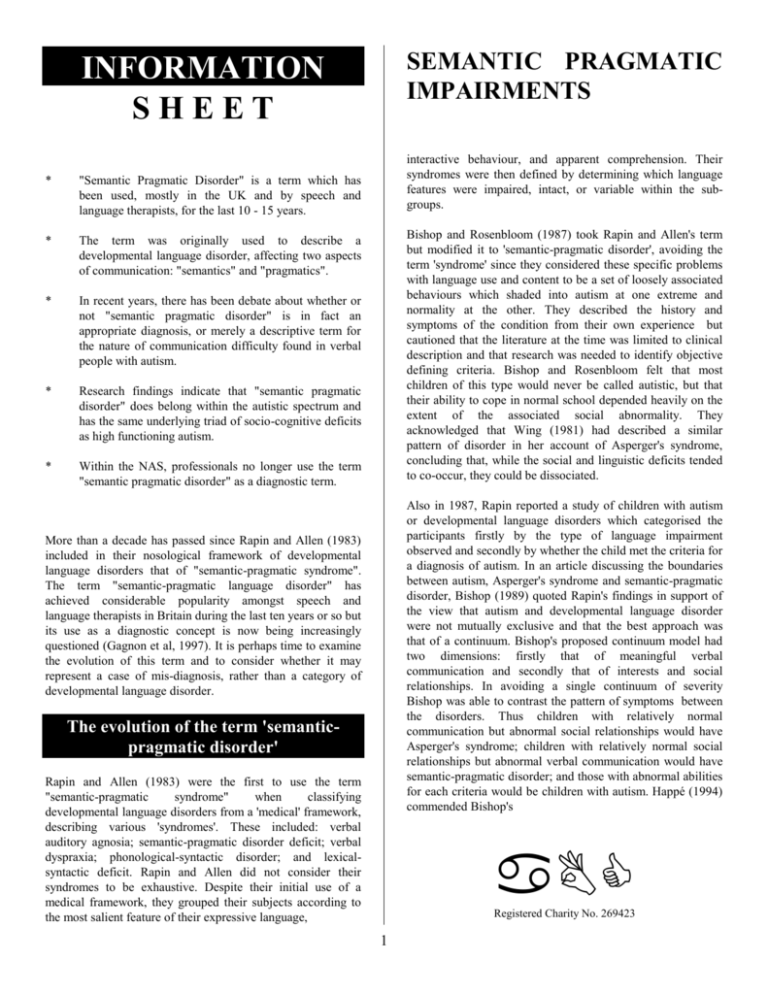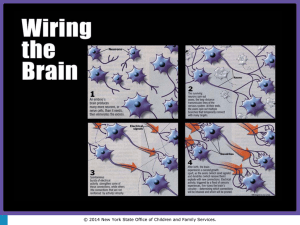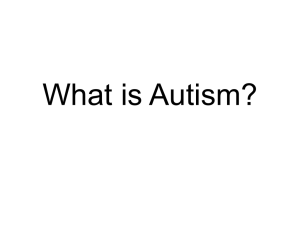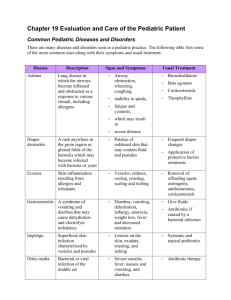Semantic Pragmatic Disorder - The National Autistic Society (Surrey
advertisement

SEMANTIC PRAGMATIC IMPAIRMENTS INFORMATION SHEET * "Semantic Pragmatic Disorder" is a term which has been used, mostly in the UK and by speech and language therapists, for the last 10 - 15 years. * The term was originally used to describe a developmental language disorder, affecting two aspects of communication: "semantics" and "pragmatics". * In recent years, there has been debate about whether or not "semantic pragmatic disorder" is in fact an appropriate diagnosis, or merely a descriptive term for the nature of communication difficulty found in verbal people with autism. * Research findings indicate that "semantic pragmatic disorder" does belong within the autistic spectrum and has the same underlying triad of socio-cognitive deficits as high functioning autism. * Within the NAS, professionals no longer use the term "semantic pragmatic disorder" as a diagnostic term. interactive behaviour, and apparent comprehension. Their syndromes were then defined by determining which language features were impaired, intact, or variable within the subgroups. Bishop and Rosenbloom (1987) took Rapin and Allen's term but modified it to 'semantic-pragmatic disorder', avoiding the term 'syndrome' since they considered these specific problems with language use and content to be a set of loosely associated behaviours which shaded into autism at one extreme and normality at the other. They described the history and symptoms of the condition from their own experience but cautioned that the literature at the time was limited to clinical description and that research was needed to identify objective defining criteria. Bishop and Rosenbloom felt that most children of this type would never be called autistic, but that their ability to cope in normal school depended heavily on the extent of the associated social abnormality. They acknowledged that Wing (1981) had described a similar pattern of disorder in her account of Asperger's syndrome, concluding that, while the social and linguistic deficits tended to co-occur, they could be dissociated. Also in 1987, Rapin reported a study of children with autism or developmental language disorders which categorised the participants firstly by the type of language impairment observed and secondly by whether the child met the criteria for a diagnosis of autism. In an article discussing the boundaries between autism, Asperger's syndrome and semantic-pragmatic disorder, Bishop (1989) quoted Rapin's findings in support of the view that autism and developmental language disorder were not mutually exclusive and that the best approach was that of a continuum. Bishop's proposed continuum model had two dimensions: firstly that of meaningful verbal communication and secondly that of interests and social relationships. In avoiding a single continuum of severity Bishop was able to contrast the pattern of symptoms between the disorders. Thus children with relatively normal communication but abnormal social relationships would have Asperger's syndrome; children with relatively normal social relationships but abnormal verbal communication would have semantic-pragmatic disorder; and those with abnormal abilities for each criteria would be children with autism. Happé (1994) commended Bishop's More than a decade has passed since Rapin and Allen (1983) included in their nosological framework of developmental language disorders that of "semantic-pragmatic syndrome". The term "semantic-pragmatic language disorder" has achieved considerable popularity amongst speech and language therapists in Britain during the last ten years or so but its use as a diagnostic concept is now being increasingly questioned (Gagnon et al, 1997). It is perhaps time to examine the evolution of this term and to consider whether it may represent a case of mis-diagnosis, rather than a category of developmental language disorder. The evolution of the term 'semanticpragmatic disorder' Rapin and Allen (1983) were the first to use the term "semantic-pragmatic syndrome" when classifying developmental language disorders from a 'medical' framework, describing various 'syndromes'. These included: verbal auditory agnosia; semantic-pragmatic disorder deficit; verbal dyspraxia; phonological-syntactic disorder; and lexicalsyntactic deficit. Rapin and Allen did not consider their syndromes to be exhaustive. Despite their initial use of a medical framework, they grouped their subjects according to the most salient feature of their expressive language, Registered Charity No. 269423 1 approach but cautioned that it presupposed there to be no necessary relationship between social and communicative competence, whereas there was in fact good reason to believe that social and communicative abilities might rely on the same cognitive mechanisms. similarities between the two groups. The two groups shared a pattern of results indicative of right hemisphere functional deficiency and of social-cognitive dysfunction. This finding supported the opinion that "semantic pragmatic disorder" is a disorder of the autistic spectrum and that the weaknesses in communicative competence may result from, or be associated with, an underlying cognitive deficit which is not primarily linguistic in nature. Early debate concerning the validity of ‘Semantic Pragmatic Disorder’ Recent debate Aarons and Gittens (1990; 1991; 1993), two speech and language therapists who were familiar with current understanding of disorders of the autistic spectrum, protested from the early 90s that children displaying the communication deficiencies described as "semantic-pragmatic disorder" were not merely language disordered but also had the underlying cognitive deficit ascribed to autism by Frith (1989). They argued in favour of diagnosing the condition as autism, since the social impairments were the most important diagnostic indicator of the true nature of the difficulties of "semanticpragmatic disorder" and since the core cognitive deficit would remain. Aarons and Gittens recommended using the term "semantic and pragmatic difficulties" descriptively, but not as a diagnostic label, since such difficulties might occur for a variety of reasons and it was essential to identify the underlying cause in order to plan effective management. They concluded that the group of children who had been labelled as having a "semantic-pragmatic language disorder" was in fact to be found at the upper end of the autistic continuum and should be diagnosed appropriately. Gagnon et al (1997) reviewed the clinical overlap between "semantic pragmatic syndrome" and high-functioning autism. They found no differential symptoms or features present in either disorder to support a distinction between the two conditions and therefore queried the continuing use of "semantic pragmatic syndrome" as a diagnostic category, or as a clinical entity. They asked: "If the semantic pragmatic diagnosis does nothing more than arbitrarily group the verbal communication deficits present in autism under a separate category, what use is there in keeping such a confounding diagnosis?" (Gagnon et al, 1997: page 45). Boucher (1998) continued this debate, noting a continuing unresolved controversy concerning diagnostic criteria for "semantic pragmatic disorder". Boucher reviewed the diagnostic status of the term and its relationship to autistic spectrum disorder, predicting that "semantic pragmatic disorder" will prove to be a valid sub-type of autism. In the same journal, in a reply to Boucher, Rapin and Allen (1998) explained their present position regarding the use of the term "semantic-pragmatic deficit syndrome". They now consider that "semantic pragmatic disorder" occurs most often in autism, and much less often in some non-autistic children with disorders such as hydrocephalus, Williams syndrome, and other brain conditions. They 'strongly disagree with the practice of using the term "semantic pragmatic disorder" to avoid having to make the more unpalatable diagnosis of an autistic spectrum disorder' (Rapin and Allen, 1998: page 86). Support for the views of Aarons and Gittens came from Brook and Bowler (1992). Noting that some polarization of views had developed between those who regarded the language problem as primary and those who regarded the social impairment as primary Brook and Bowler reviewed the literature of studies of children with language disorders characterized by semantic and pragmatic impairments. They classified the descriptions of these children using Wing and Gould's (1979) criteria for inclusion in the autistic continuum. Brook and Bowler concluded that some of these semantic and pragmatic impairments resulted from the same fundamental cognitive and interpersonal difficulties found in autism. It seemed to them that "semantic-pragmatic disorder" and "highlevel autism" were different perceptions of the same phenomenon and that research was needed to investigate the social-cognitive abilities of children labelled as having "semantic-pragmatic disorder". The current position There is now consensus amongst many professionals working with disorders of the autistic spectrum, that "semantic pragmatic disorder" should be viewed as part of the autistic spectrum, rather than as a developmental language disorder. Clinical experience and follow-up of children given the "semantic pragmatic disorder" diagnosis during the late 1980s and early 1990s indicates that most members of this group have continuing social difficulties, even when their language improves (Shields 1998: personal experience and consultation with others). Research findings In a study investigating the brain bases of developmental language disorders, Shields et al (1996a; 1996b) compared children with "semantic pragmatic disorder" and children with high functioning autism on batteries of neuropsychological tests, including tests of social cognition, and found striking Whilst it may be useful to use the term "semantic and pragmatic difficulties" in a descriptive way, to indicate the 2 nature of the presenting communication deficits, the use of the term "semantic pragmatic disorder" as a diagnostic label can mask the underlying socio-cognitive deficits and restrict the available help for the child's special educational needs. As Wing comments (1996: page 73): 'Most people in the field of autistic disorders do not consider there is any value in separating semantic-pragmatic disorder from the autistic spectrum. The disadvantage of doing so is the failure to recognize the child's whole pattern of disabilities and therefore a failure to address all their needs. It is also most misleading for the parents.' Rapin, I. 1987: Developmental dysphasia and autism in preschool children: characteristics and subtypes. Proceedings of the First International Symposium, specific speech and language disorders in children. University of Reading, England. Rapin, I. and Allen, D.A. 1983: Developmental language disorders: nosological considerations. In: Kirk, U., editor, Neuropsychology of language, reading and spelling. New York: Academic Press. Rapin, I. and Allen, D.A. 1998: The semantic-pragmatic deficit disorder: classification issues. International Journal of Language and Communication Disorders, 33 (1), pp. 82-87. Dr Jane Shields July 1998 Shields, J., et al. 1996a: Hemispheric function in developmental language disorders and high level autism. Developmental Medicine and Child Neurology, 38, pp. 473486. References Aarons, M. and Gittens, T. 1990: What is the true essence of autism? Speech Therapy in Practice, January 1990, pp. 2-3. Shields, J., et al. 1996b: Social cognition in developmental language disorders and high-level autism. Developmental Medicine and Child Neurology, 38, pp. 487-495. Aarons, M. and Gittens, T. 1991: Autism as a context. College of Speech and Language Therapists Bulletin, December 1991, pp. 6-8. Wing, L. 1981: Asperger's syndrome: a clinical account. Psychological Medicine, 11, pp. 115-129. Aarons, M. and Gittens, T. 1993: Semantic-pragmatic disorder (or a little bit autistic?) College of Speech and Language Therapists Bulletin, June 1993, p.18. Wing, L. 1996: The Autistic Spectrum: a guide for parents and professionals. London: Constable. Bishop, D.V.M. 1989: Autism, Asperger's syndrome and semantic-pragmatic disorder: Where are the boundaries? British Journal of Disorders of Communication, 24 (2), pp.107-121. Wing, L. and Gould, J. 1979: Severe impairments of social interaction and associated abnormalities in children: epidemiology and classification. Journal of Autism and Developmental Disorders, 9, pp.11-30. Bishop, D.V.M. and Rosenbloom, L. 1987: Childhood language disorders: Classification and overview. In: Yule, W. and Rutter, M. editors, Language development and disorders. London: MacKeith Press. Boucher, J. 1998: SPD as a distinct diagnostic entity: logical considerations and directions for future research. International Journal of Language and Communication Disorders, 33 (1), pp. 71-108. Brook, S.L. and Bowler, D. 1992: Autism by another name? Semantic and pragmatic impairments in children. Journal of Autism and Developmental Disorders, 22, pp. 61-81. The National Autistic Society, 393 City Road, London, EC1V 1NG, UK; tel: + 44 (0) 171 833 2299; fax: + 44 (0) 171 833 9666; email: nas@nas.org.uk website: http://www.oneworld.org/autism_uk/ Frith, U. 1989: Autism - explaining the enigma. Oxford: Basil Blackwell. Gagnon, L.; Mottron, L. and Joanette, Y. 1997: Questioning the validity of the semantic pragmatic syndrome diagnosis. Autism, 1 (1), pp. 37-55. © The National Autistic Society October 1998 Happé, F.G.E. 1994: Autism: an introduction to psychological theory. London: UCL Press. 3







